SCMIC3003 Clinical Microbiology Mini-Review: Bird Flu and Markets
VerifiedAdded on 2022/09/17
|13
|3527
|28
Report
AI Summary
This mini-review examines avian influenza (bird flu), a zoonotic disease, focusing on the H5N1 virus and its implications. The review provides an overview of the pathogen, including its structure and genetic characteristics, and discusses the role of live animal markets in the disease's emergence, spread, and geographical distribution. It highlights risk factors, such as direct contact with infected birds and the environmental conditions of live markets, and explores biological and social contributing factors. The report also details control mechanisms, including hygiene practices, global surveillance, and antiviral treatments, emphasizing the importance of collaboration between global health organizations to prevent and manage outbreaks. The review underscores the need for proactive measures to mitigate the risks associated with zoonotic diseases and protect public health.
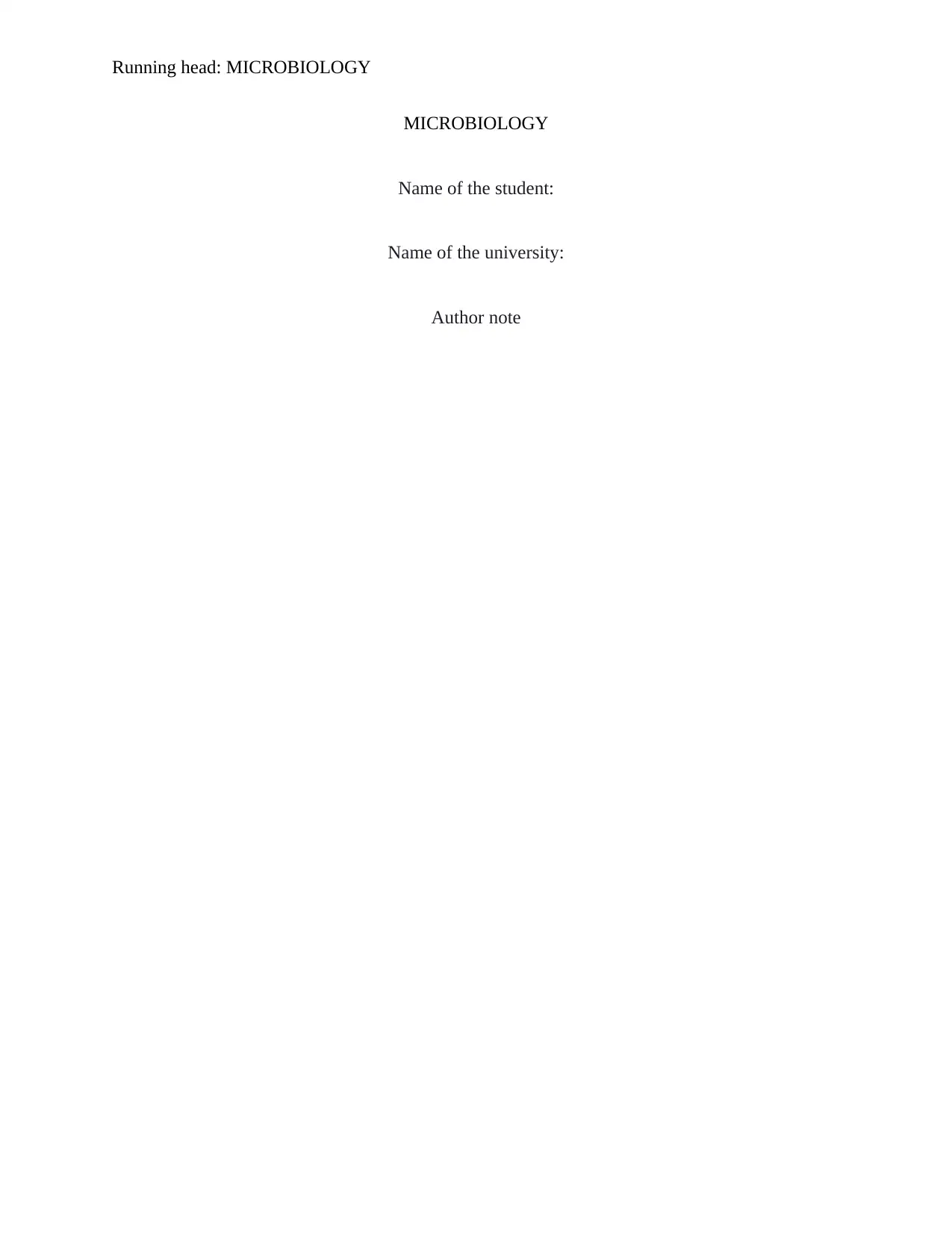
Running head: MICROBIOLOGY
MICROBIOLOGY
Name of the student:
Name of the university:
Author note
MICROBIOLOGY
Name of the student:
Name of the university:
Author note
Paraphrase This Document
Need a fresh take? Get an instant paraphrase of this document with our AI Paraphraser

1
MICROBIOLOGY
Introduction:
With the high prevalence of the chronic diseases, improvements in surveillance facilitated
better recognition of emerging zoonotic diseases around the globe. Zoonotic diseases are
considered as those infections which can be spread between animals and humans with or without
vectors. Nelson and Vincent (2015), highlighted that approximately 1500 pathogens cause
infection to human and 61% of these pathogens causes’ zoonotic diseases.Many researchers
reported that zoonotic diseases are most common in United States where more than 6 people out
of 10 people are experiencing infectious diseases which are spread from animals .(Loh et al.
2015). The most common zoonotic disease in the United States includes salmonellosis,
gastroenteritis, bird flu, giardiasis, and rabbis (Nolen et al. 2016). In the majority of the
cases, these infections spread through direct contact, indirect contact, vector-borne and food-
born. While anyone can be infected by zoonotic diseases, children younger than 5 years, adults
older than 65 and people with a weakened immune system are at high risk of developing diseases
(Pantin-Jackwood et al. 2017). Hence, this paper aimed to focus on one such zoonotic disease
such as bird flu where the causative agent is avian influenza (H5N1). This paper will provide an
overview of the pathogen and the disease it causes, an overview of live animal markets, the
environment around the market, the reason behind the association of animal market, risk,
biological factors, and control mechanism of the infection in following paragraphs.
Discussion:
Overview of pathogen:
Influenza type A viruses are of most significance to public health because of their
potential attributes for causing an influenza pandemic. Highly pathogenic influenza infection has
MICROBIOLOGY
Introduction:
With the high prevalence of the chronic diseases, improvements in surveillance facilitated
better recognition of emerging zoonotic diseases around the globe. Zoonotic diseases are
considered as those infections which can be spread between animals and humans with or without
vectors. Nelson and Vincent (2015), highlighted that approximately 1500 pathogens cause
infection to human and 61% of these pathogens causes’ zoonotic diseases.Many researchers
reported that zoonotic diseases are most common in United States where more than 6 people out
of 10 people are experiencing infectious diseases which are spread from animals .(Loh et al.
2015). The most common zoonotic disease in the United States includes salmonellosis,
gastroenteritis, bird flu, giardiasis, and rabbis (Nolen et al. 2016). In the majority of the
cases, these infections spread through direct contact, indirect contact, vector-borne and food-
born. While anyone can be infected by zoonotic diseases, children younger than 5 years, adults
older than 65 and people with a weakened immune system are at high risk of developing diseases
(Pantin-Jackwood et al. 2017). Hence, this paper aimed to focus on one such zoonotic disease
such as bird flu where the causative agent is avian influenza (H5N1). This paper will provide an
overview of the pathogen and the disease it causes, an overview of live animal markets, the
environment around the market, the reason behind the association of animal market, risk,
biological factors, and control mechanism of the infection in following paragraphs.
Discussion:
Overview of pathogen:
Influenza type A viruses are of most significance to public health because of their
potential attributes for causing an influenza pandemic. Highly pathogenic influenza infection has
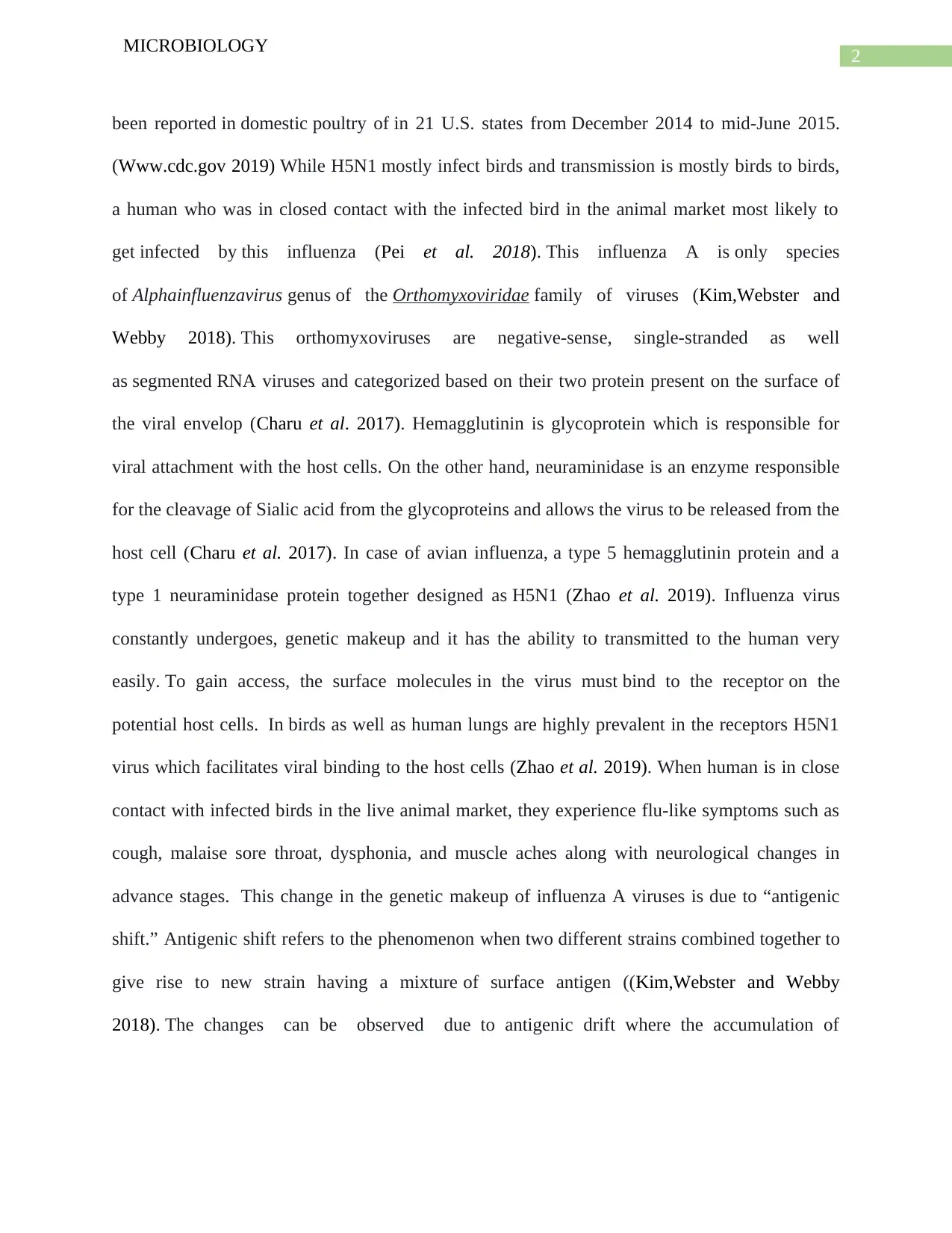
2
MICROBIOLOGY
been reported in domestic poultry of in 21 U.S. states from December 2014 to mid-June 2015.
(Www.cdc.gov 2019) While H5N1 mostly infect birds and transmission is mostly birds to birds,
a human who was in closed contact with the infected bird in the animal market most likely to
get infected by this influenza (Pei et al. 2018). This influenza A is only species
of Alphainfluenzavirus genus of the Orthomyxoviridae family of viruses (Kim,Webster and
Webby 2018). This orthomyxoviruses are negative-sense, single-stranded as well
as segmented RNA viruses and categorized based on their two protein present on the surface of
the viral envelop (Charu et al. 2017). Hemagglutinin is glycoprotein which is responsible for
viral attachment with the host cells. On the other hand, neuraminidase is an enzyme responsible
for the cleavage of Sialic acid from the glycoproteins and allows the virus to be released from the
host cell (Charu et al. 2017). In case of avian influenza, a type 5 hemagglutinin protein and a
type 1 neuraminidase protein together designed as H5N1 (Zhao et al. 2019). Influenza virus
constantly undergoes, genetic makeup and it has the ability to transmitted to the human very
easily. To gain access, the surface molecules in the virus must bind to the receptor on the
potential host cells. In birds as well as human lungs are highly prevalent in the receptors H5N1
virus which facilitates viral binding to the host cells (Zhao et al. 2019). When human is in close
contact with infected birds in the live animal market, they experience flu-like symptoms such as
cough, malaise sore throat, dysphonia, and muscle aches along with neurological changes in
advance stages. This change in the genetic makeup of influenza A viruses is due to “antigenic
shift.” Antigenic shift refers to the phenomenon when two different strains combined together to
give rise to new strain having a mixture of surface antigen ((Kim,Webster and Webby
2018). The changes can be observed due to antigenic drift where the accumulation of
MICROBIOLOGY
been reported in domestic poultry of in 21 U.S. states from December 2014 to mid-June 2015.
(Www.cdc.gov 2019) While H5N1 mostly infect birds and transmission is mostly birds to birds,
a human who was in closed contact with the infected bird in the animal market most likely to
get infected by this influenza (Pei et al. 2018). This influenza A is only species
of Alphainfluenzavirus genus of the Orthomyxoviridae family of viruses (Kim,Webster and
Webby 2018). This orthomyxoviruses are negative-sense, single-stranded as well
as segmented RNA viruses and categorized based on their two protein present on the surface of
the viral envelop (Charu et al. 2017). Hemagglutinin is glycoprotein which is responsible for
viral attachment with the host cells. On the other hand, neuraminidase is an enzyme responsible
for the cleavage of Sialic acid from the glycoproteins and allows the virus to be released from the
host cell (Charu et al. 2017). In case of avian influenza, a type 5 hemagglutinin protein and a
type 1 neuraminidase protein together designed as H5N1 (Zhao et al. 2019). Influenza virus
constantly undergoes, genetic makeup and it has the ability to transmitted to the human very
easily. To gain access, the surface molecules in the virus must bind to the receptor on the
potential host cells. In birds as well as human lungs are highly prevalent in the receptors H5N1
virus which facilitates viral binding to the host cells (Zhao et al. 2019). When human is in close
contact with infected birds in the live animal market, they experience flu-like symptoms such as
cough, malaise sore throat, dysphonia, and muscle aches along with neurological changes in
advance stages. This change in the genetic makeup of influenza A viruses is due to “antigenic
shift.” Antigenic shift refers to the phenomenon when two different strains combined together to
give rise to new strain having a mixture of surface antigen ((Kim,Webster and Webby
2018). The changes can be observed due to antigenic drift where the accumulation of
⊘ This is a preview!⊘
Do you want full access?
Subscribe today to unlock all pages.

Trusted by 1+ million students worldwide
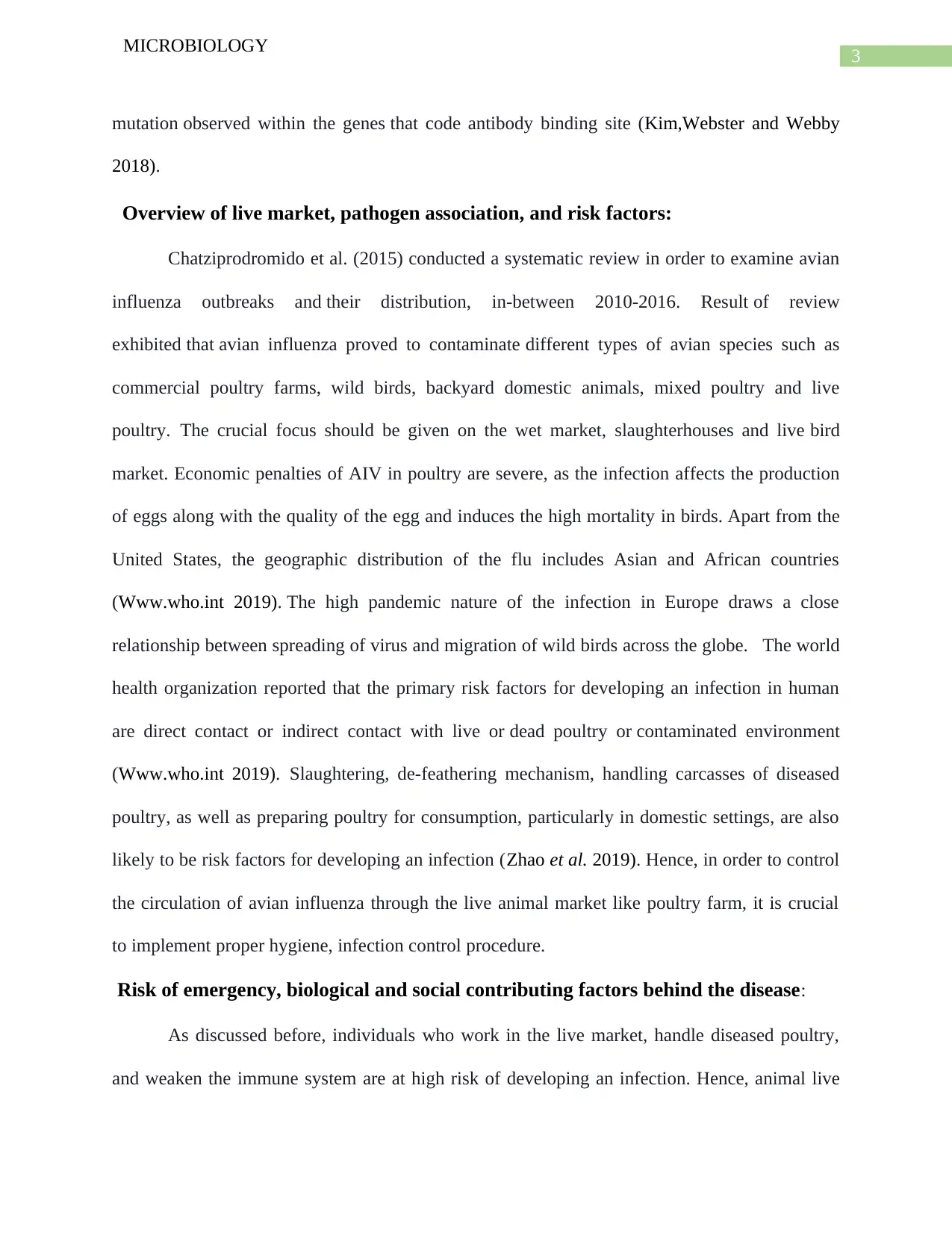
3
MICROBIOLOGY
mutation observed within the genes that code antibody binding site (Kim,Webster and Webby
2018).
Overview of live market, pathogen association, and risk factors:
Chatziprodromido et al. (2015) conducted a systematic review in order to examine avian
influenza outbreaks and their distribution, in-between 2010-2016. Result of review
exhibited that avian influenza proved to contaminate different types of avian species such as
commercial poultry farms, wild birds, backyard domestic animals, mixed poultry and live
poultry. The crucial focus should be given on the wet market, slaughterhouses and live bird
market. Economic penalties of AIV in poultry are severe, as the infection affects the production
of eggs along with the quality of the egg and induces the high mortality in birds. Apart from the
United States, the geographic distribution of the flu includes Asian and African countries
(Www.who.int 2019). The high pandemic nature of the infection in Europe draws a close
relationship between spreading of virus and migration of wild birds across the globe. The world
health organization reported that the primary risk factors for developing an infection in human
are direct contact or indirect contact with live or dead poultry or contaminated environment
(Www.who.int 2019). Slaughtering, de-feathering mechanism, handling carcasses of diseased
poultry, as well as preparing poultry for consumption, particularly in domestic settings, are also
likely to be risk factors for developing an infection (Zhao et al. 2019). Hence, in order to control
the circulation of avian influenza through the live animal market like poultry farm, it is crucial
to implement proper hygiene, infection control procedure.
Risk of emergency, biological and social contributing factors behind the disease:
As discussed before, individuals who work in the live market, handle diseased poultry,
and weaken the immune system are at high risk of developing an infection. Hence, animal live
MICROBIOLOGY
mutation observed within the genes that code antibody binding site (Kim,Webster and Webby
2018).
Overview of live market, pathogen association, and risk factors:
Chatziprodromido et al. (2015) conducted a systematic review in order to examine avian
influenza outbreaks and their distribution, in-between 2010-2016. Result of review
exhibited that avian influenza proved to contaminate different types of avian species such as
commercial poultry farms, wild birds, backyard domestic animals, mixed poultry and live
poultry. The crucial focus should be given on the wet market, slaughterhouses and live bird
market. Economic penalties of AIV in poultry are severe, as the infection affects the production
of eggs along with the quality of the egg and induces the high mortality in birds. Apart from the
United States, the geographic distribution of the flu includes Asian and African countries
(Www.who.int 2019). The high pandemic nature of the infection in Europe draws a close
relationship between spreading of virus and migration of wild birds across the globe. The world
health organization reported that the primary risk factors for developing an infection in human
are direct contact or indirect contact with live or dead poultry or contaminated environment
(Www.who.int 2019). Slaughtering, de-feathering mechanism, handling carcasses of diseased
poultry, as well as preparing poultry for consumption, particularly in domestic settings, are also
likely to be risk factors for developing an infection (Zhao et al. 2019). Hence, in order to control
the circulation of avian influenza through the live animal market like poultry farm, it is crucial
to implement proper hygiene, infection control procedure.
Risk of emergency, biological and social contributing factors behind the disease:
As discussed before, individuals who work in the live market, handle diseased poultry,
and weaken the immune system are at high risk of developing an infection. Hence, animal live
Paraphrase This Document
Need a fresh take? Get an instant paraphrase of this document with our AI Paraphraser
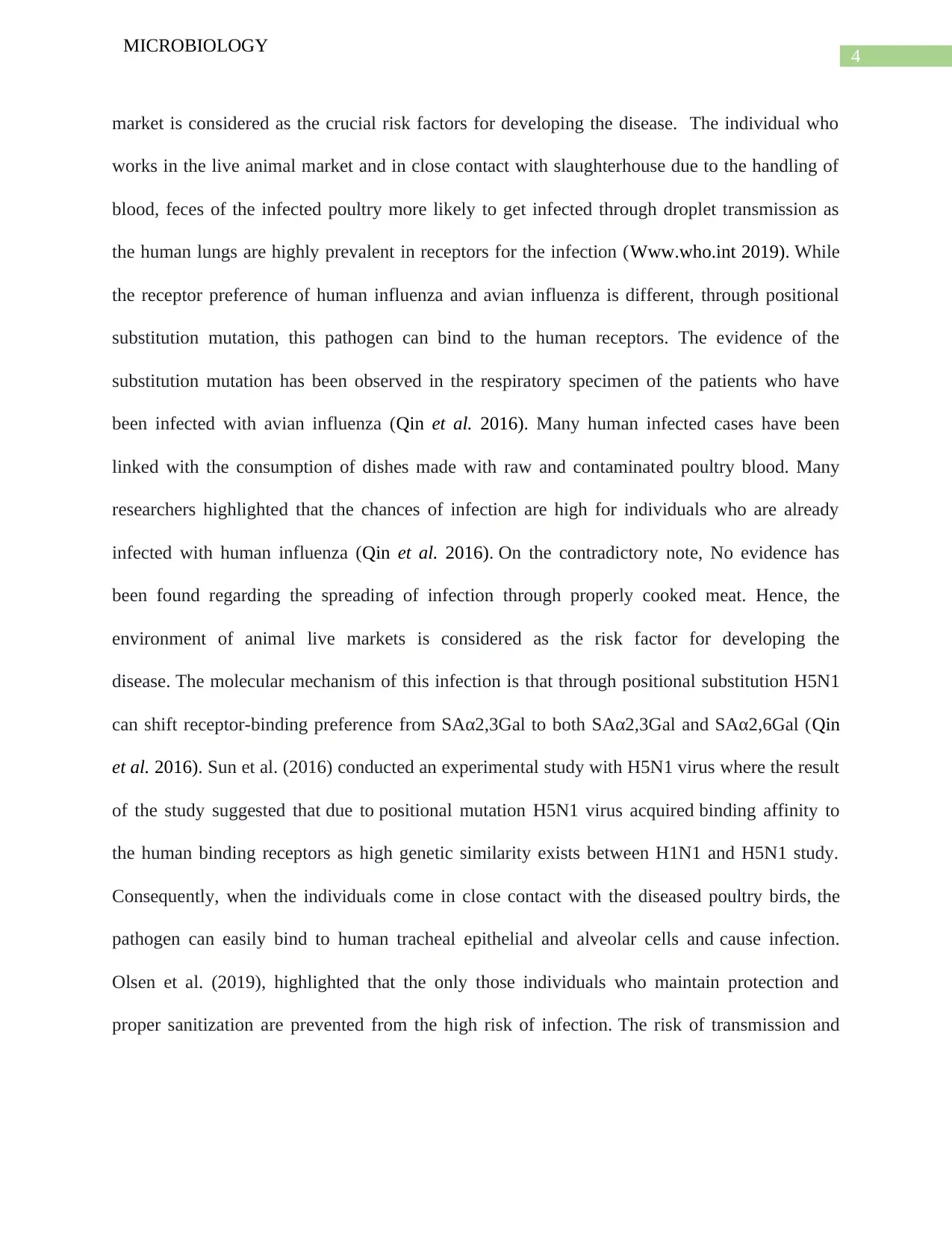
4
MICROBIOLOGY
market is considered as the crucial risk factors for developing the disease. The individual who
works in the live animal market and in close contact with slaughterhouse due to the handling of
blood, feces of the infected poultry more likely to get infected through droplet transmission as
the human lungs are highly prevalent in receptors for the infection (Www.who.int 2019). While
the receptor preference of human influenza and avian influenza is different, through positional
substitution mutation, this pathogen can bind to the human receptors. The evidence of the
substitution mutation has been observed in the respiratory specimen of the patients who have
been infected with avian influenza (Qin et al. 2016). Many human infected cases have been
linked with the consumption of dishes made with raw and contaminated poultry blood. Many
researchers highlighted that the chances of infection are high for individuals who are already
infected with human influenza (Qin et al. 2016). On the contradictory note, No evidence has
been found regarding the spreading of infection through properly cooked meat. Hence, the
environment of animal live markets is considered as the risk factor for developing the
disease. The molecular mechanism of this infection is that through positional substitution H5N1
can shift receptor-binding preference from SAα2,3Gal to both SAα2,3Gal and SAα2,6Gal (Qin
et al. 2016). Sun et al. (2016) conducted an experimental study with H5N1 virus where the result
of the study suggested that due to positional mutation H5N1 virus acquired binding affinity to
the human binding receptors as high genetic similarity exists between H1N1 and H5N1 study.
Consequently, when the individuals come in close contact with the diseased poultry birds, the
pathogen can easily bind to human tracheal epithelial and alveolar cells and cause infection.
Olsen et al. (2019), highlighted that the only those individuals who maintain protection and
proper sanitization are prevented from the high risk of infection. The risk of transmission and
MICROBIOLOGY
market is considered as the crucial risk factors for developing the disease. The individual who
works in the live animal market and in close contact with slaughterhouse due to the handling of
blood, feces of the infected poultry more likely to get infected through droplet transmission as
the human lungs are highly prevalent in receptors for the infection (Www.who.int 2019). While
the receptor preference of human influenza and avian influenza is different, through positional
substitution mutation, this pathogen can bind to the human receptors. The evidence of the
substitution mutation has been observed in the respiratory specimen of the patients who have
been infected with avian influenza (Qin et al. 2016). Many human infected cases have been
linked with the consumption of dishes made with raw and contaminated poultry blood. Many
researchers highlighted that the chances of infection are high for individuals who are already
infected with human influenza (Qin et al. 2016). On the contradictory note, No evidence has
been found regarding the spreading of infection through properly cooked meat. Hence, the
environment of animal live markets is considered as the risk factor for developing the
disease. The molecular mechanism of this infection is that through positional substitution H5N1
can shift receptor-binding preference from SAα2,3Gal to both SAα2,3Gal and SAα2,6Gal (Qin
et al. 2016). Sun et al. (2016) conducted an experimental study with H5N1 virus where the result
of the study suggested that due to positional mutation H5N1 virus acquired binding affinity to
the human binding receptors as high genetic similarity exists between H1N1 and H5N1 study.
Consequently, when the individuals come in close contact with the diseased poultry birds, the
pathogen can easily bind to human tracheal epithelial and alveolar cells and cause infection.
Olsen et al. (2019), highlighted that the only those individuals who maintain protection and
proper sanitization are prevented from the high risk of infection. The risk of transmission and
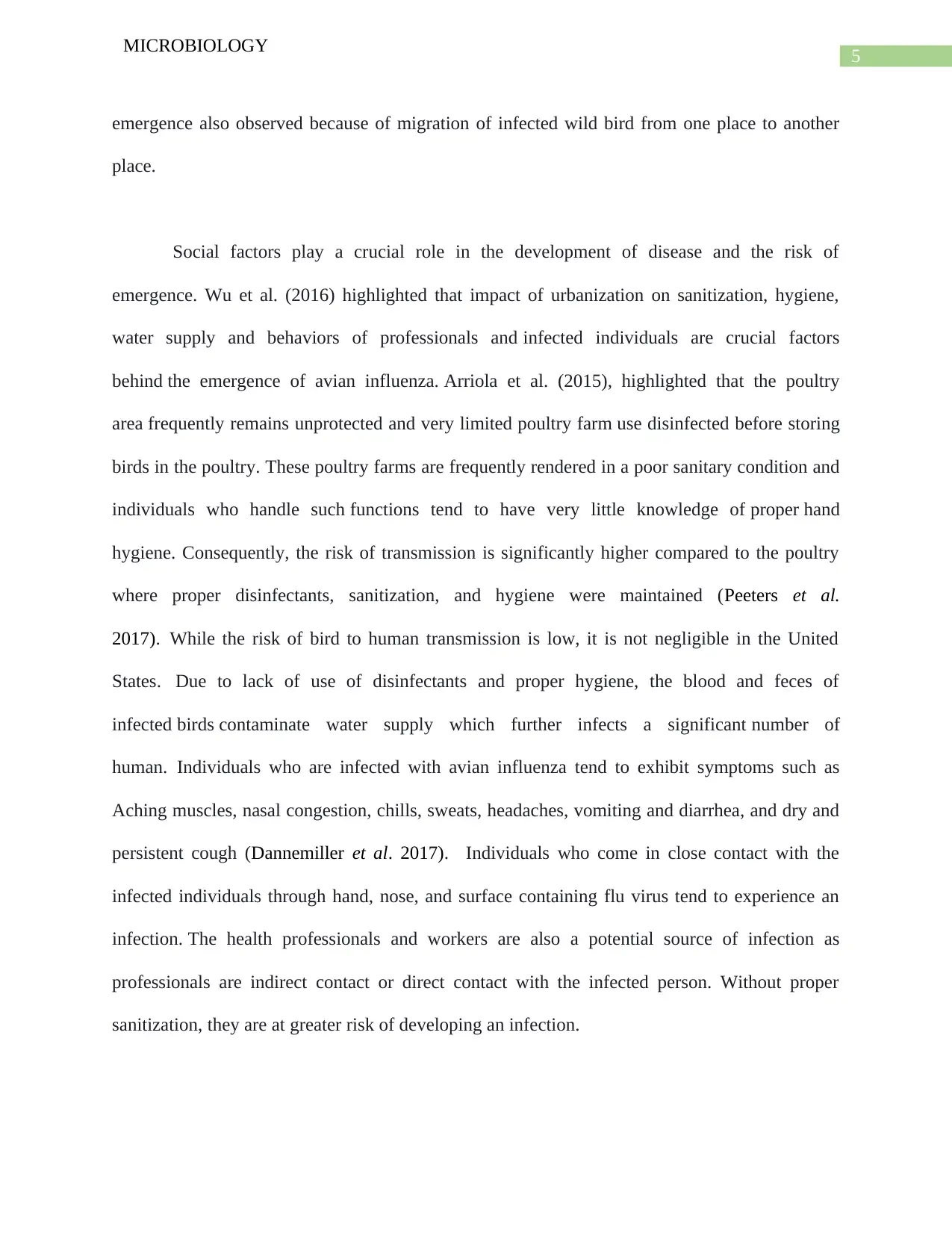
5
MICROBIOLOGY
emergence also observed because of migration of infected wild bird from one place to another
place.
Social factors play a crucial role in the development of disease and the risk of
emergence. Wu et al. (2016) highlighted that impact of urbanization on sanitization, hygiene,
water supply and behaviors of professionals and infected individuals are crucial factors
behind the emergence of avian influenza. Arriola et al. (2015), highlighted that the poultry
area frequently remains unprotected and very limited poultry farm use disinfected before storing
birds in the poultry. These poultry farms are frequently rendered in a poor sanitary condition and
individuals who handle such functions tend to have very little knowledge of proper hand
hygiene. Consequently, the risk of transmission is significantly higher compared to the poultry
where proper disinfectants, sanitization, and hygiene were maintained (Peeters et al.
2017). While the risk of bird to human transmission is low, it is not negligible in the United
States. Due to lack of use of disinfectants and proper hygiene, the blood and feces of
infected birds contaminate water supply which further infects a significant number of
human. Individuals who are infected with avian influenza tend to exhibit symptoms such as
Aching muscles, nasal congestion, chills, sweats, headaches, vomiting and diarrhea, and dry and
persistent cough (Dannemiller et al. 2017). Individuals who come in close contact with the
infected individuals through hand, nose, and surface containing flu virus tend to experience an
infection. The health professionals and workers are also a potential source of infection as
professionals are indirect contact or direct contact with the infected person. Without proper
sanitization, they are at greater risk of developing an infection.
MICROBIOLOGY
emergence also observed because of migration of infected wild bird from one place to another
place.
Social factors play a crucial role in the development of disease and the risk of
emergence. Wu et al. (2016) highlighted that impact of urbanization on sanitization, hygiene,
water supply and behaviors of professionals and infected individuals are crucial factors
behind the emergence of avian influenza. Arriola et al. (2015), highlighted that the poultry
area frequently remains unprotected and very limited poultry farm use disinfected before storing
birds in the poultry. These poultry farms are frequently rendered in a poor sanitary condition and
individuals who handle such functions tend to have very little knowledge of proper hand
hygiene. Consequently, the risk of transmission is significantly higher compared to the poultry
where proper disinfectants, sanitization, and hygiene were maintained (Peeters et al.
2017). While the risk of bird to human transmission is low, it is not negligible in the United
States. Due to lack of use of disinfectants and proper hygiene, the blood and feces of
infected birds contaminate water supply which further infects a significant number of
human. Individuals who are infected with avian influenza tend to exhibit symptoms such as
Aching muscles, nasal congestion, chills, sweats, headaches, vomiting and diarrhea, and dry and
persistent cough (Dannemiller et al. 2017). Individuals who come in close contact with the
infected individuals through hand, nose, and surface containing flu virus tend to experience an
infection. The health professionals and workers are also a potential source of infection as
professionals are indirect contact or direct contact with the infected person. Without proper
sanitization, they are at greater risk of developing an infection.
⊘ This is a preview!⊘
Do you want full access?
Subscribe today to unlock all pages.

Trusted by 1+ million students worldwide

6
MICROBIOLOGY
Control mechanism:
In the global level, WHO collaborates with global health partners and agencies which
involves the Food and Agriculture Organization of the United Nations (FAO) and the World
Organization for Animal Health (OIE), in order to control along with preventing the spread of
animal diseases (Www.who.int 2019). The Global Influenza Surveillance and Response System
(GISRS), WHO’s global laboratory system, identify as well as monitors strains
of transmitting influenza viruses and provides possible intervention to manage and prevent an
outbreak.
As a standard precaution, in order to reduce the infection, WHO recommends that
poultry, as well as poultry products along with wild game birds, should always be prepared
following good hygienic practices and poultry meat should be properly cooked (Www.who.int
2019). As a general precaution, the CDC recommended that people should avoid direct contact
with a domestic bird that appeared to be ill (Www.cdc.gov 2019). In order to avoid contact
Personal Protective Equipment should be given. PPE refers to the equipment’s protective
clothing gloves, face shields, goggles and facemasks which are given to the patients from
spreading of infections. Good respiratory hygiene can be implemented locally for reducing the
high prevalence of the infection. Good food hygiene practices such as washing hands with soap
and water can be implemented through proper education (Www.cdc.gov 2019). The health
promotion campaign is required to design where education regarding the world health
organization guided five moments of hand hygiene should be provided to the population. The
people who exposed to the infected birds should screen their own health for possible
symptoms such as flu-like symptoms. Health care providers are required to evaluate patients with
MICROBIOLOGY
Control mechanism:
In the global level, WHO collaborates with global health partners and agencies which
involves the Food and Agriculture Organization of the United Nations (FAO) and the World
Organization for Animal Health (OIE), in order to control along with preventing the spread of
animal diseases (Www.who.int 2019). The Global Influenza Surveillance and Response System
(GISRS), WHO’s global laboratory system, identify as well as monitors strains
of transmitting influenza viruses and provides possible intervention to manage and prevent an
outbreak.
As a standard precaution, in order to reduce the infection, WHO recommends that
poultry, as well as poultry products along with wild game birds, should always be prepared
following good hygienic practices and poultry meat should be properly cooked (Www.who.int
2019). As a general precaution, the CDC recommended that people should avoid direct contact
with a domestic bird that appeared to be ill (Www.cdc.gov 2019). In order to avoid contact
Personal Protective Equipment should be given. PPE refers to the equipment’s protective
clothing gloves, face shields, goggles and facemasks which are given to the patients from
spreading of infections. Good respiratory hygiene can be implemented locally for reducing the
high prevalence of the infection. Good food hygiene practices such as washing hands with soap
and water can be implemented through proper education (Www.cdc.gov 2019). The health
promotion campaign is required to design where education regarding the world health
organization guided five moments of hand hygiene should be provided to the population. The
people who exposed to the infected birds should screen their own health for possible
symptoms such as flu-like symptoms. Health care providers are required to evaluate patients with
Paraphrase This Document
Need a fresh take? Get an instant paraphrase of this document with our AI Paraphraser
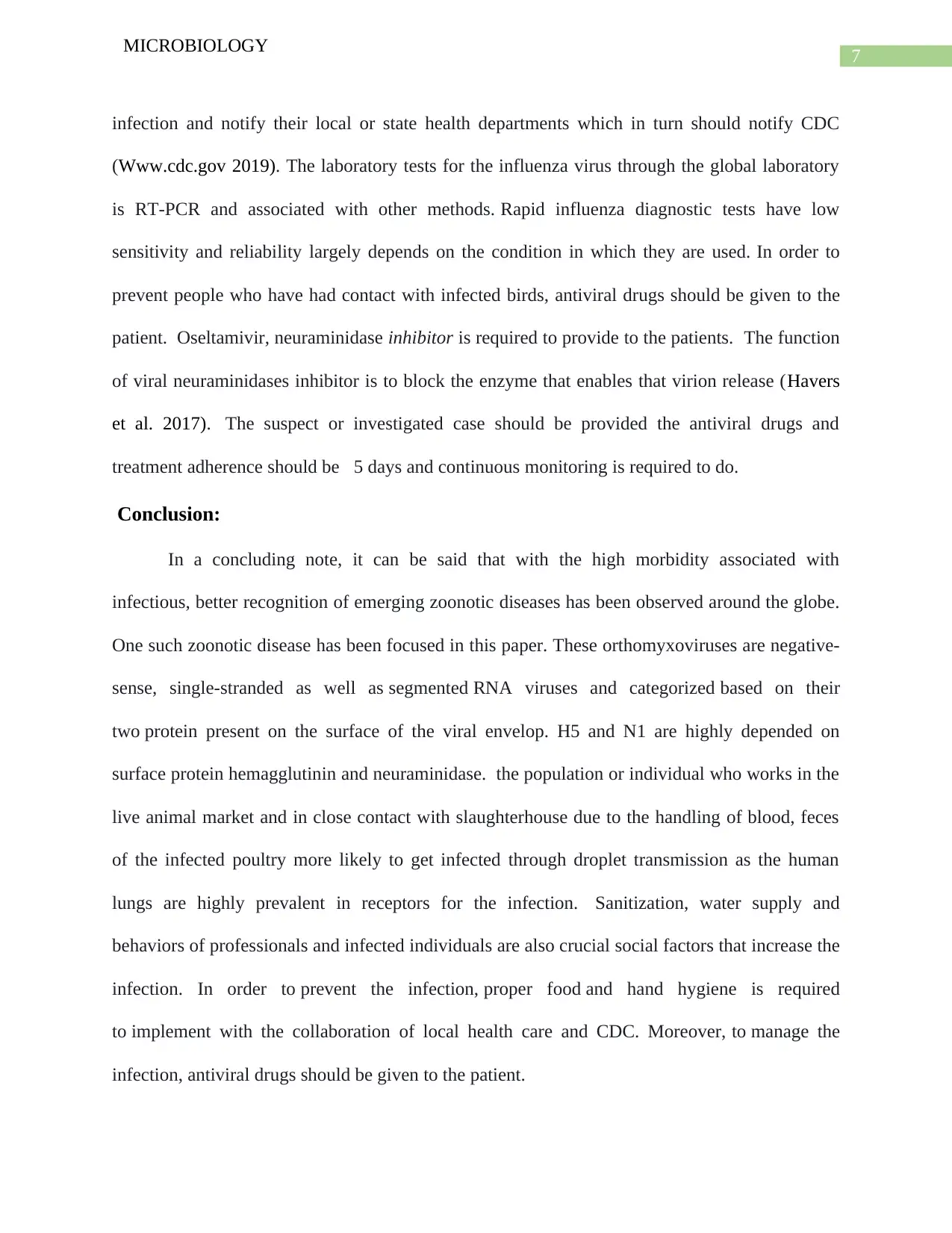
7
MICROBIOLOGY
infection and notify their local or state health departments which in turn should notify CDC
(Www.cdc.gov 2019). The laboratory tests for the influenza virus through the global laboratory
is RT-PCR and associated with other methods. Rapid influenza diagnostic tests have low
sensitivity and reliability largely depends on the condition in which they are used. In order to
prevent people who have had contact with infected birds, antiviral drugs should be given to the
patient. Oseltamivir, neuraminidase inhibitor is required to provide to the patients. The function
of viral neuraminidases inhibitor is to block the enzyme that enables that virion release (Havers
et al. 2017). The suspect or investigated case should be provided the antiviral drugs and
treatment adherence should be 5 days and continuous monitoring is required to do.
Conclusion:
In a concluding note, it can be said that with the high morbidity associated with
infectious, better recognition of emerging zoonotic diseases has been observed around the globe.
One such zoonotic disease has been focused in this paper. These orthomyxoviruses are negative-
sense, single-stranded as well as segmented RNA viruses and categorized based on their
two protein present on the surface of the viral envelop. H5 and N1 are highly depended on
surface protein hemagglutinin and neuraminidase. the population or individual who works in the
live animal market and in close contact with slaughterhouse due to the handling of blood, feces
of the infected poultry more likely to get infected through droplet transmission as the human
lungs are highly prevalent in receptors for the infection. Sanitization, water supply and
behaviors of professionals and infected individuals are also crucial social factors that increase the
infection. In order to prevent the infection, proper food and hand hygiene is required
to implement with the collaboration of local health care and CDC. Moreover, to manage the
infection, antiviral drugs should be given to the patient.
MICROBIOLOGY
infection and notify their local or state health departments which in turn should notify CDC
(Www.cdc.gov 2019). The laboratory tests for the influenza virus through the global laboratory
is RT-PCR and associated with other methods. Rapid influenza diagnostic tests have low
sensitivity and reliability largely depends on the condition in which they are used. In order to
prevent people who have had contact with infected birds, antiviral drugs should be given to the
patient. Oseltamivir, neuraminidase inhibitor is required to provide to the patients. The function
of viral neuraminidases inhibitor is to block the enzyme that enables that virion release (Havers
et al. 2017). The suspect or investigated case should be provided the antiviral drugs and
treatment adherence should be 5 days and continuous monitoring is required to do.
Conclusion:
In a concluding note, it can be said that with the high morbidity associated with
infectious, better recognition of emerging zoonotic diseases has been observed around the globe.
One such zoonotic disease has been focused in this paper. These orthomyxoviruses are negative-
sense, single-stranded as well as segmented RNA viruses and categorized based on their
two protein present on the surface of the viral envelop. H5 and N1 are highly depended on
surface protein hemagglutinin and neuraminidase. the population or individual who works in the
live animal market and in close contact with slaughterhouse due to the handling of blood, feces
of the infected poultry more likely to get infected through droplet transmission as the human
lungs are highly prevalent in receptors for the infection. Sanitization, water supply and
behaviors of professionals and infected individuals are also crucial social factors that increase the
infection. In order to prevent the infection, proper food and hand hygiene is required
to implement with the collaboration of local health care and CDC. Moreover, to manage the
infection, antiviral drugs should be given to the patient.

8
MICROBIOLOGY
MICROBIOLOGY
⊘ This is a preview!⊘
Do you want full access?
Subscribe today to unlock all pages.

Trusted by 1+ million students worldwide
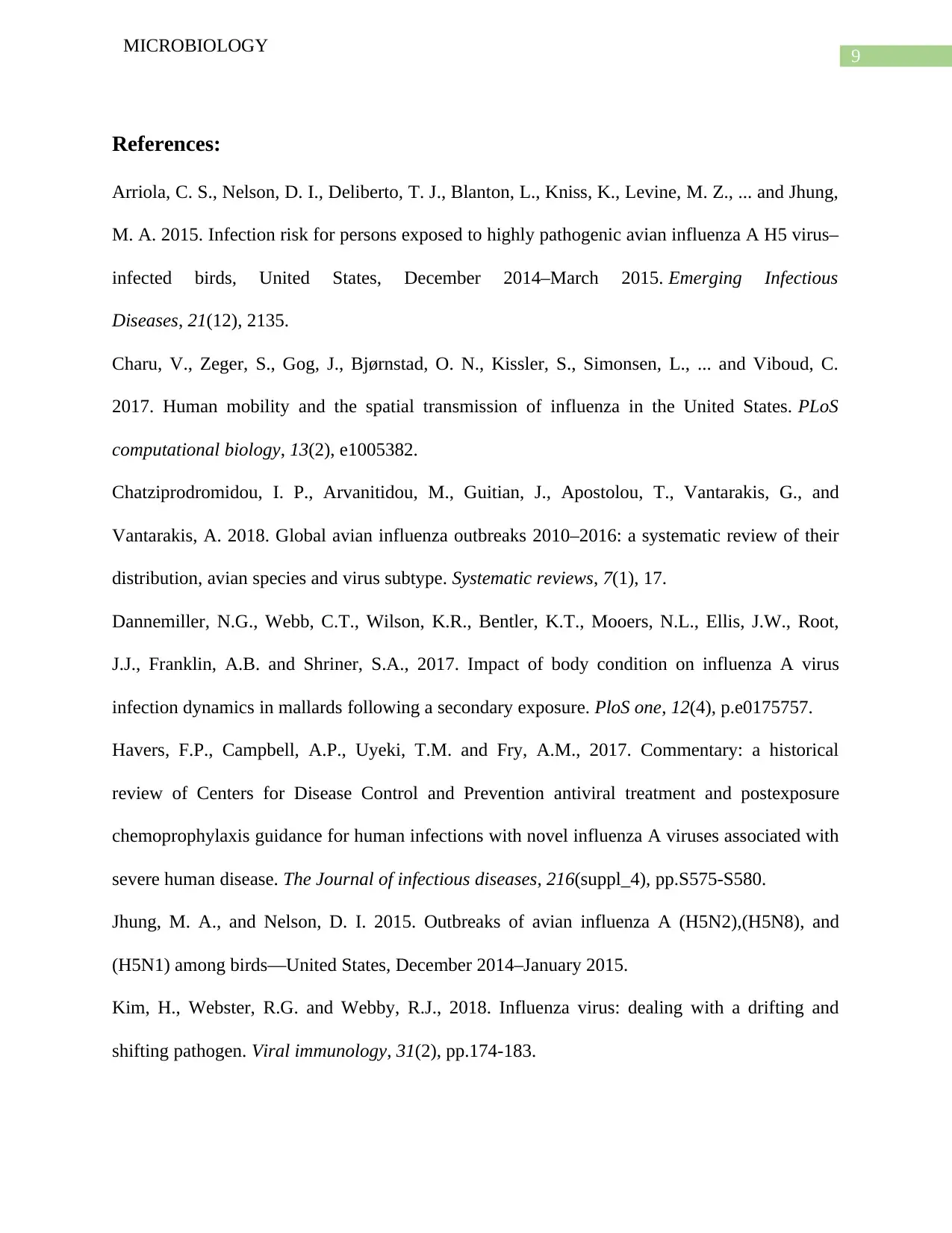
9
MICROBIOLOGY
References:
Arriola, C. S., Nelson, D. I., Deliberto, T. J., Blanton, L., Kniss, K., Levine, M. Z., ... and Jhung,
M. A. 2015. Infection risk for persons exposed to highly pathogenic avian influenza A H5 virus–
infected birds, United States, December 2014–March 2015. Emerging Infectious
Diseases, 21(12), 2135.
Charu, V., Zeger, S., Gog, J., Bjørnstad, O. N., Kissler, S., Simonsen, L., ... and Viboud, C.
2017. Human mobility and the spatial transmission of influenza in the United States. PLoS
computational biology, 13(2), e1005382.
Chatziprodromidou, I. P., Arvanitidou, M., Guitian, J., Apostolou, T., Vantarakis, G., and
Vantarakis, A. 2018. Global avian influenza outbreaks 2010–2016: a systematic review of their
distribution, avian species and virus subtype. Systematic reviews, 7(1), 17.
Dannemiller, N.G., Webb, C.T., Wilson, K.R., Bentler, K.T., Mooers, N.L., Ellis, J.W., Root,
J.J., Franklin, A.B. and Shriner, S.A., 2017. Impact of body condition on influenza A virus
infection dynamics in mallards following a secondary exposure. PloS one, 12(4), p.e0175757.
Havers, F.P., Campbell, A.P., Uyeki, T.M. and Fry, A.M., 2017. Commentary: a historical
review of Centers for Disease Control and Prevention antiviral treatment and postexposure
chemoprophylaxis guidance for human infections with novel influenza A viruses associated with
severe human disease. The Journal of infectious diseases, 216(suppl_4), pp.S575-S580.
Jhung, M. A., and Nelson, D. I. 2015. Outbreaks of avian influenza A (H5N2),(H5N8), and
(H5N1) among birds—United States, December 2014–January 2015.
Kim, H., Webster, R.G. and Webby, R.J., 2018. Influenza virus: dealing with a drifting and
shifting pathogen. Viral immunology, 31(2), pp.174-183.
MICROBIOLOGY
References:
Arriola, C. S., Nelson, D. I., Deliberto, T. J., Blanton, L., Kniss, K., Levine, M. Z., ... and Jhung,
M. A. 2015. Infection risk for persons exposed to highly pathogenic avian influenza A H5 virus–
infected birds, United States, December 2014–March 2015. Emerging Infectious
Diseases, 21(12), 2135.
Charu, V., Zeger, S., Gog, J., Bjørnstad, O. N., Kissler, S., Simonsen, L., ... and Viboud, C.
2017. Human mobility and the spatial transmission of influenza in the United States. PLoS
computational biology, 13(2), e1005382.
Chatziprodromidou, I. P., Arvanitidou, M., Guitian, J., Apostolou, T., Vantarakis, G., and
Vantarakis, A. 2018. Global avian influenza outbreaks 2010–2016: a systematic review of their
distribution, avian species and virus subtype. Systematic reviews, 7(1), 17.
Dannemiller, N.G., Webb, C.T., Wilson, K.R., Bentler, K.T., Mooers, N.L., Ellis, J.W., Root,
J.J., Franklin, A.B. and Shriner, S.A., 2017. Impact of body condition on influenza A virus
infection dynamics in mallards following a secondary exposure. PloS one, 12(4), p.e0175757.
Havers, F.P., Campbell, A.P., Uyeki, T.M. and Fry, A.M., 2017. Commentary: a historical
review of Centers for Disease Control and Prevention antiviral treatment and postexposure
chemoprophylaxis guidance for human infections with novel influenza A viruses associated with
severe human disease. The Journal of infectious diseases, 216(suppl_4), pp.S575-S580.
Jhung, M. A., and Nelson, D. I. 2015. Outbreaks of avian influenza A (H5N2),(H5N8), and
(H5N1) among birds—United States, December 2014–January 2015.
Kim, H., Webster, R.G. and Webby, R.J., 2018. Influenza virus: dealing with a drifting and
shifting pathogen. Viral immunology, 31(2), pp.174-183.
Paraphrase This Document
Need a fresh take? Get an instant paraphrase of this document with our AI Paraphraser
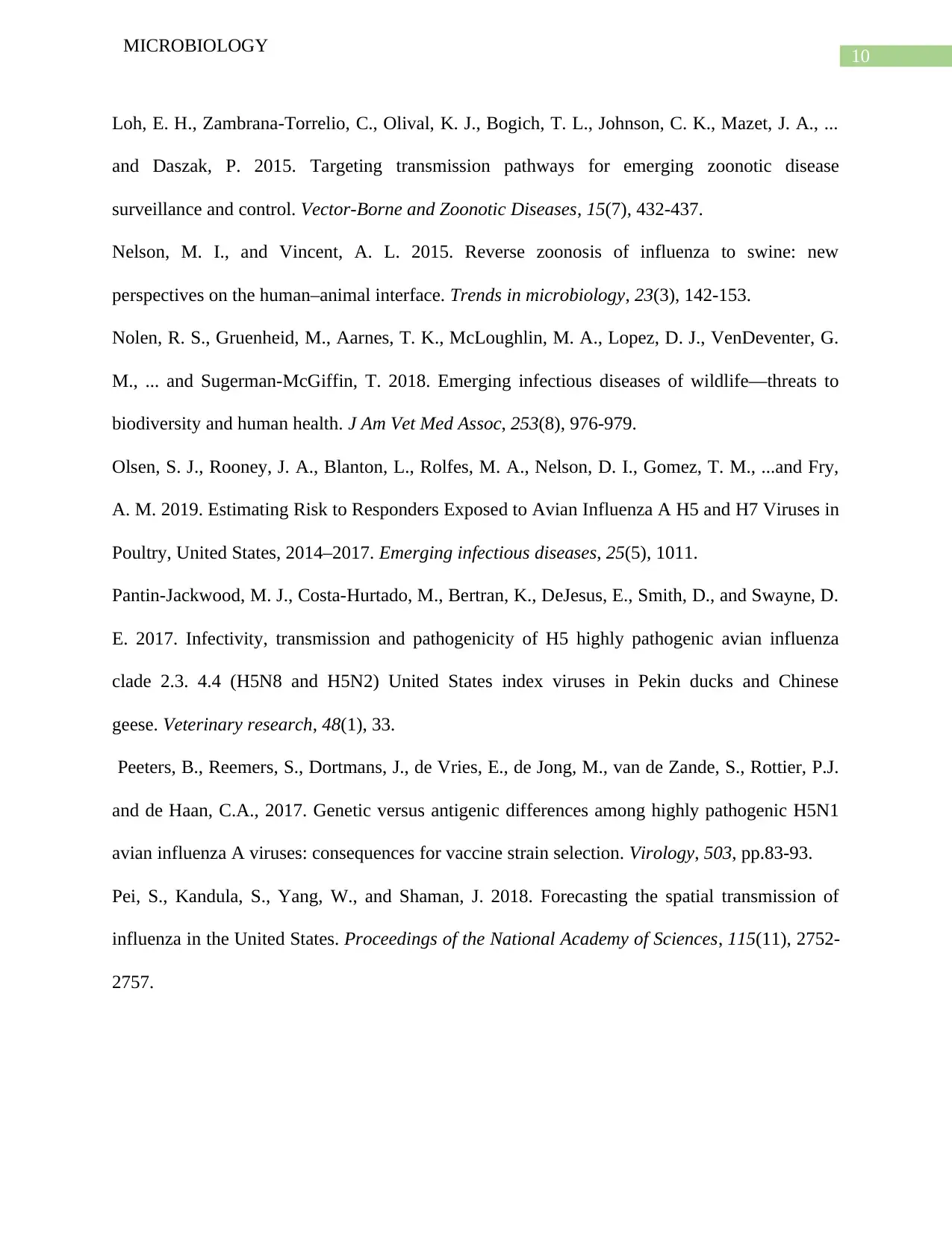
10
MICROBIOLOGY
Loh, E. H., Zambrana-Torrelio, C., Olival, K. J., Bogich, T. L., Johnson, C. K., Mazet, J. A., ...
and Daszak, P. 2015. Targeting transmission pathways for emerging zoonotic disease
surveillance and control. Vector-Borne and Zoonotic Diseases, 15(7), 432-437.
Nelson, M. I., and Vincent, A. L. 2015. Reverse zoonosis of influenza to swine: new
perspectives on the human–animal interface. Trends in microbiology, 23(3), 142-153.
Nolen, R. S., Gruenheid, M., Aarnes, T. K., McLoughlin, M. A., Lopez, D. J., VenDeventer, G.
M., ... and Sugerman-McGiffin, T. 2018. Emerging infectious diseases of wildlife—threats to
biodiversity and human health. J Am Vet Med Assoc, 253(8), 976-979.
Olsen, S. J., Rooney, J. A., Blanton, L., Rolfes, M. A., Nelson, D. I., Gomez, T. M., ...and Fry,
A. M. 2019. Estimating Risk to Responders Exposed to Avian Influenza A H5 and H7 Viruses in
Poultry, United States, 2014–2017. Emerging infectious diseases, 25(5), 1011.
Pantin-Jackwood, M. J., Costa-Hurtado, M., Bertran, K., DeJesus, E., Smith, D., and Swayne, D.
E. 2017. Infectivity, transmission and pathogenicity of H5 highly pathogenic avian influenza
clade 2.3. 4.4 (H5N8 and H5N2) United States index viruses in Pekin ducks and Chinese
geese. Veterinary research, 48(1), 33.
Peeters, B., Reemers, S., Dortmans, J., de Vries, E., de Jong, M., van de Zande, S., Rottier, P.J.
and de Haan, C.A., 2017. Genetic versus antigenic differences among highly pathogenic H5N1
avian influenza A viruses: consequences for vaccine strain selection. Virology, 503, pp.83-93.
Pei, S., Kandula, S., Yang, W., and Shaman, J. 2018. Forecasting the spatial transmission of
influenza in the United States. Proceedings of the National Academy of Sciences, 115(11), 2752-
2757.
MICROBIOLOGY
Loh, E. H., Zambrana-Torrelio, C., Olival, K. J., Bogich, T. L., Johnson, C. K., Mazet, J. A., ...
and Daszak, P. 2015. Targeting transmission pathways for emerging zoonotic disease
surveillance and control. Vector-Borne and Zoonotic Diseases, 15(7), 432-437.
Nelson, M. I., and Vincent, A. L. 2015. Reverse zoonosis of influenza to swine: new
perspectives on the human–animal interface. Trends in microbiology, 23(3), 142-153.
Nolen, R. S., Gruenheid, M., Aarnes, T. K., McLoughlin, M. A., Lopez, D. J., VenDeventer, G.
M., ... and Sugerman-McGiffin, T. 2018. Emerging infectious diseases of wildlife—threats to
biodiversity and human health. J Am Vet Med Assoc, 253(8), 976-979.
Olsen, S. J., Rooney, J. A., Blanton, L., Rolfes, M. A., Nelson, D. I., Gomez, T. M., ...and Fry,
A. M. 2019. Estimating Risk to Responders Exposed to Avian Influenza A H5 and H7 Viruses in
Poultry, United States, 2014–2017. Emerging infectious diseases, 25(5), 1011.
Pantin-Jackwood, M. J., Costa-Hurtado, M., Bertran, K., DeJesus, E., Smith, D., and Swayne, D.
E. 2017. Infectivity, transmission and pathogenicity of H5 highly pathogenic avian influenza
clade 2.3. 4.4 (H5N8 and H5N2) United States index viruses in Pekin ducks and Chinese
geese. Veterinary research, 48(1), 33.
Peeters, B., Reemers, S., Dortmans, J., de Vries, E., de Jong, M., van de Zande, S., Rottier, P.J.
and de Haan, C.A., 2017. Genetic versus antigenic differences among highly pathogenic H5N1
avian influenza A viruses: consequences for vaccine strain selection. Virology, 503, pp.83-93.
Pei, S., Kandula, S., Yang, W., and Shaman, J. 2018. Forecasting the spatial transmission of
influenza in the United States. Proceedings of the National Academy of Sciences, 115(11), 2752-
2757.

11
MICROBIOLOGY
Qin, Y., Horby, P. W., Tsang, T. K., Chen, E., Gao, L., Ou, J., ... Wu, P. 2015. Differences in
the epidemiology of human cases of avian influenza A (H7N9) and A (H5N1) viruses
infection. Clinical Infectious Diseases, 61(4), 563-571.
Sun, H., Pu, J., Wei, Y., Sun, Y., Hu, J., Liu, L. and Liu, J. 2016. Highly Pathogenic Avian
Influenza H5N6 Viruses Exhibit Enhanced Affinity for Human Type Sialic Acid Receptor and
In-Contact Transmission in Model Ferrets. Journal of virology, 90(14), 6235–6243.
doi:10.1128/JVI.00127-16
Wu, X., Lu, Y., Zhou, S., Chen, L., and Xu, B. 2016. Impact of climate change on human
infectious diseases: Empirical evidence and human adaptation. Environment international, 86,
14-23.
Www.cdc.gov 2019. H5 Viruses in the United States | Avian Influenza (Flu). [online] Cdc.gov.
Available at: https://www.cdc.gov/flu/avianflu/h5/index.htm [Accessed 23 Aug. 2019].
Www.cdc.gov 2019. Outbreaks of North American Lineage Avian Influenza Viruses. [online]
Cdc.gov. Available at: https://www.cdc.gov/flu/avianflu/north-american-lineage.htm [Accessed
23 Aug. 2019].
Www.who.int 2019. Influenza (Avian and other zoonotic). [Online] Who.int. Available at:
https://www.who.int/news-room/fact-sheets/detail/influenza-(avian-and-other-zoonotic)
[Accessed 23 Aug. 2019].
Www.who.int 2019. WHO | FAQs: H5N1 influenza. [Online] Who.int. Available at:
https://www.who.int/influenza/human_animal_interface/avian_influenza/h5n1_research/faqs/en/
[Accessed 23 Aug. 2019].
MICROBIOLOGY
Qin, Y., Horby, P. W., Tsang, T. K., Chen, E., Gao, L., Ou, J., ... Wu, P. 2015. Differences in
the epidemiology of human cases of avian influenza A (H7N9) and A (H5N1) viruses
infection. Clinical Infectious Diseases, 61(4), 563-571.
Sun, H., Pu, J., Wei, Y., Sun, Y., Hu, J., Liu, L. and Liu, J. 2016. Highly Pathogenic Avian
Influenza H5N6 Viruses Exhibit Enhanced Affinity for Human Type Sialic Acid Receptor and
In-Contact Transmission in Model Ferrets. Journal of virology, 90(14), 6235–6243.
doi:10.1128/JVI.00127-16
Wu, X., Lu, Y., Zhou, S., Chen, L., and Xu, B. 2016. Impact of climate change on human
infectious diseases: Empirical evidence and human adaptation. Environment international, 86,
14-23.
Www.cdc.gov 2019. H5 Viruses in the United States | Avian Influenza (Flu). [online] Cdc.gov.
Available at: https://www.cdc.gov/flu/avianflu/h5/index.htm [Accessed 23 Aug. 2019].
Www.cdc.gov 2019. Outbreaks of North American Lineage Avian Influenza Viruses. [online]
Cdc.gov. Available at: https://www.cdc.gov/flu/avianflu/north-american-lineage.htm [Accessed
23 Aug. 2019].
Www.who.int 2019. Influenza (Avian and other zoonotic). [Online] Who.int. Available at:
https://www.who.int/news-room/fact-sheets/detail/influenza-(avian-and-other-zoonotic)
[Accessed 23 Aug. 2019].
Www.who.int 2019. WHO | FAQs: H5N1 influenza. [Online] Who.int. Available at:
https://www.who.int/influenza/human_animal_interface/avian_influenza/h5n1_research/faqs/en/
[Accessed 23 Aug. 2019].
⊘ This is a preview!⊘
Do you want full access?
Subscribe today to unlock all pages.

Trusted by 1+ million students worldwide
1 out of 13
Related Documents
Your All-in-One AI-Powered Toolkit for Academic Success.
+13062052269
info@desklib.com
Available 24*7 on WhatsApp / Email
![[object Object]](/_next/static/media/star-bottom.7253800d.svg)
Unlock your academic potential
Copyright © 2020–2025 A2Z Services. All Rights Reserved. Developed and managed by ZUCOL.





